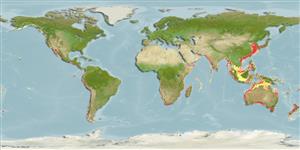Classification / Names
Common names from other countries
Main reference
Size / Weight / Age
Max length : 39.5 cm SL male/unsexed; (Ref. 9291); common length : 20.0 cm SL male/unsexed; (Ref. 188); max. published weight: 486.00 g (Ref. 6885); max. reported age: 25 years (Ref. 188)
Length at first maturity
Lm 9.0 range ? - ? cm
Environment
Marine; pelagic-neritic; oceanodromous (Ref. 51243); depth range 0 - 200 m (Ref. 188)
Climate / Range
Subtropical; 9°C - 21°C (Ref. 6390), preferred 23°C (Ref. 107945); 61°N - 47°S, 145°W - 180°E (Ref. 36641)
Distribution
Indo-Pacific: southern Africa to the eastern Pacific (Ref. 27267). Three lineages were confirmed through cluster and parsimony analyses of haplotypic divergences: southern Africa (ocellatus) and Australia (neopilchardus); Chile (sagax) and California (caeruleus); and, Japan (melanostictus) (Ref. 36641).
Countries | FAO areas | Ecosystems | Occurrences | Introductions
Short description
Dorsal
spines
(total): 0;
Dorsal
soft rays
(total): 13-21;
Anal
spines: 0;
Anal
soft rays: 12 - 23;
Vertebrae: 48 - 54. Body cylindrical and elongate; ventral part of operculum with clear cut bony striae radiating downwards; belly rounded with ventral scutes; back blue green; flanks white, with 1 to 3 series of dark spots along the middle (Ref. 55763). The radiating bony striae on the operculum distinguish this species from all other clupeids in the area. The radiating bony striae on the operculum distinguish this fish from all other clupeids in the area. In New Zealand the species appears to grow larger (21.3 cm standard length; cf. 19.7 cm), has slightly larger eggs and a higher mean number of vertebrae (50.52; cf. 49 to 50.08 in various samples) (Ref. 859).
IUCN Red List Status (Ref. 115185)
Threat to humans
Harmless
Human uses
Fisheries: highly commercial; bait: usually
Tools
Special reports
Download XML
Internet sources
Estimates of some properties based on models
Phylogenetic diversity index
PD50 = 1.0000 many relatives (e.g. carps) 0.5 - 2.0 few relatives (e.g. lungfishes)
Trophic Level
2.8 ±0.1 se; Based on diet studies.
Resilience
Medium, minimum population doubling time 1.4 - 4.4 years (K=0.45; tm=2; tmax=13-25; Fec=10,000)
Vulnerability
Low to moderate vulnerability (34 of 100)
Price category
